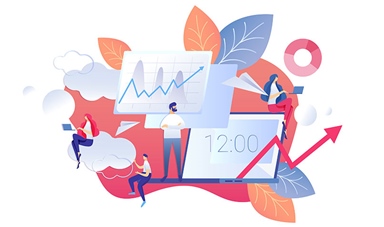Loading component...
At a glance
Modern workplaces change at a startling pace. The skills and knowledge acquired in a one-size-fits-all university degree obtained a decade or more ago quickly become superseded by technological advances and new methodologies.
As a result, a new model of learning, known as micro-credentialing, has emerged to fulfil the urgent need for upskilling and retraining in the digital economy.
What are micro-credentials?
In a paper for Deakin University, Emeritus Professor Beverley Oliver defines a microcredential as “a certification of assessed learning that is additional, alternate, complementary to or a formal component of a formal qualification”.
A micro-credential, she writes, is “shorter, contemporary, inexpensive, online and manageable on a mobile phone”.
There are two broad types of microcredential. One is credit bearing, incorporating an assessment component and contributing to a formal qualification.
A non-credit-bearing micro-credential in the form of an in-house digital badge or a massive open online course (MOOC) may still require assessment, but does not contribute to a formal qualification or necessarily adhere to a set academic standard.
The need for flexibility in education
The constantly changing digital economy has created a strong demand for education, retraining and upskilling in the workforce. For many people, however, traditional undergraduate and postgraduate courses do not fit their professional needs – they are too costly, too time-consuming, or don’t deliver the necessary skills.
Oliver argues that in the future, workers will need “more and better granular certified learning” to demonstrate their educational currency.
“Micro-credentials are one way to enable the certification of new skills, as well as validate the skills already acquired through experience.”
One major selling point for microcredentials, particularly among mature learners who need to upskill, but are juggling competing demands of work and family, is flexibility, says Professor Ian Harper, dean of Melbourne Business School.
A degree requires a commitment of time, which may not suit someone who wants the freedom to take up a new job offer or wants to join the workforce as quickly as possible with a cutting-edge skill set.
Education providers seeking to adapt to the new learning landscape need to be able to say to clients, “we can offer you expertise in these separate areas – you decide the sequence in which you want to do them, driven by the demands of your workplace or your career objectives”, Harper says.
“[It] gives people a measure of choice over the rate at which they acquire the skills that they need…that isn’t available with the standard one-size-fits-all menu.”
Micro-Credentials
Improving employability
Micro-credentials allow education providers and industry to work together to retrain workers, bridge skills gaps and certify prior learning.
For learners, a micro-credential’s value lies in its potential to improve employment outcomes: to provide pathways to work experience, job opportunities, promotion or formal qualifications.
Micro-credentials also allow for better integration of work and study.
“The idea that you can apply the ideas that you’re being taught in formal education almost immediately in your workplace, or vice versa … strengthens the quality of the education that you receive,” Harper says.
"With thoughtful implementation, micro-credentials can supplement and complement quality higher education systems and enable opportunities for learners across the lifespan.”
At this stage, comparing micro-credentials can be like comparing apples and oranges due to a lack of standardisation. Oliver recommends the introduction of a national standards framework to regulate micro-credentials, where “critical information summaries” provide details about content and certification.
“Providers need clear policies and procedures to ensure arm’s-length quality assurance.”
According to Harper, it’s the market that decides a micro-credential’s worth. Only a university has the licence to create sub-degree credentials. The value of a micro-credential offered by a private organisation is ultimately determined by the employees who do the course and potential employers who consider its weight when comparing candidates’ CVs.
What micro-credentials mean for the MBA
At Melbourne Business School, microcredentials currently offered within the executive education program, a traditionally flexible offering of short courses, are overseen by the university’s Academic Programs Committee (APC).
The credit gained after passing a credentialed course can “stack up” to count towards a formal degree.
“At this stage, you couldn’t do an entire degree by accumulating lots and lots of these micro-credentials,” notes Harper. “That is something that may well happen, but at this stage, you can’t.”
While Harper believes micro-credentialing makes Melbourne Business School’s executive education function more appealing to clients, he says the model has not diminished the demand for macro-credentials like the MBA. “What we have had is a demand for people doing executive education who want to be able to show something for it.”
Harper, for his part, does not view microcredentialing as an existential threat to macro-credentials such as the MBA, which he describes as a professional “rite of passage” that offers value beyond the course content delivered by lecturers. The connections made within the classroom can lead to critical networking opportunities and business partnerships long after the course has finished.
“All micro-credentialing can do is enable you to pick off the individual bits of subject matter,” he says.
Oliver similarly believes that, rather than replacing the MBA, micro-credentials present a chance for formal and non-formal learning to work in concert.
“With thoughtful implementation,” she writes, “micro-credentials can supplement and complement quality higher education systems and enable opportunities for learners across the lifespan.”
Skills top-up
The case for microcredentialing in your organisation
- It makes learning a habit.
- It helps in career planning.
- It can be included in a company’s leadership development program.
- It lets employees pivot if they want to.
CPA Australia's micro-credentialed courses cover the most in-demand business and finance skills, and are flexible, relevant, and provide life-long learning opportunities. Find out more here.

